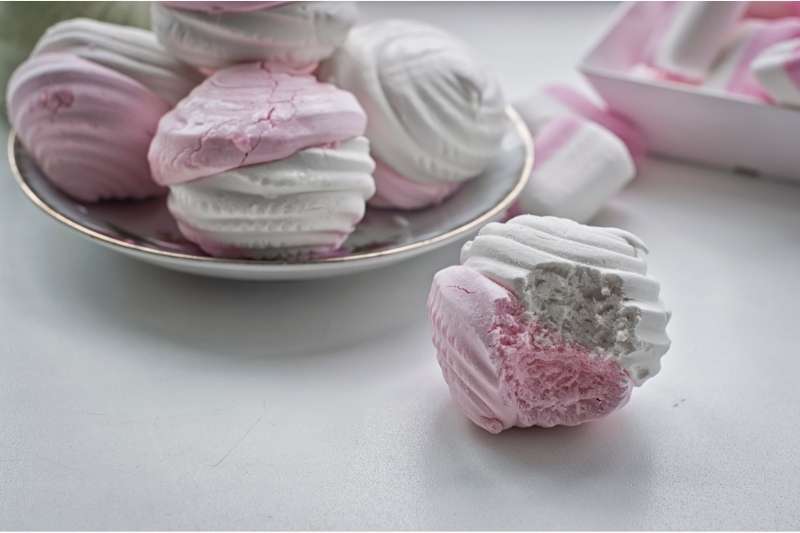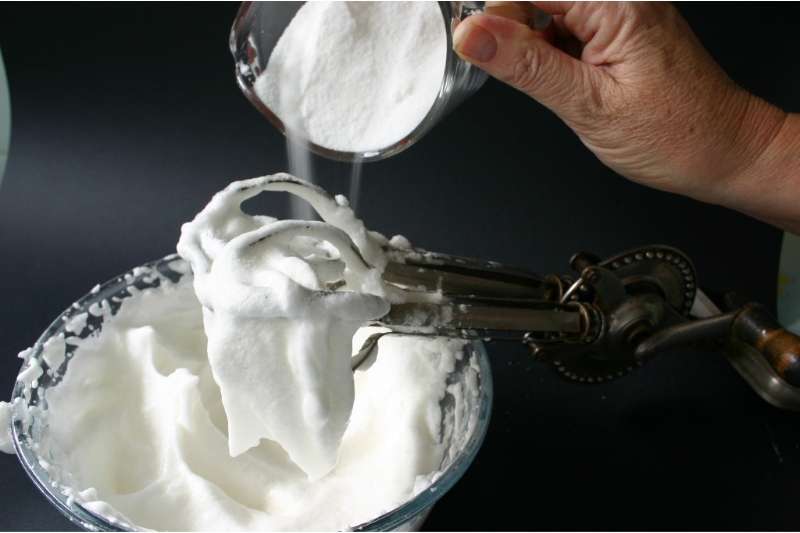This post contains affiliate links.
Meringue is a delicious dessert that can be made for any occasion. It does not matter if you are looking to feed a large crowd or just your family, Meringue is the perfect treat. However, sometimes people run into the problem of their meringue coming out too chewy and difficult to enjoy. This is due to a couple of reasons.
As a general rule, one of the most common reasons for chewy Meringue is improperly mixing the ingredients. The ingredients should be mixed at room temperature, but the egg whites must be separated while they are still cold from the fridge.
While this is the main reason I’ve found to make my meringue chewy, there are many other reasons why this may be happening to you. In this article, I will explore all the common causes that make your meringue chewy, how to fix them as well as how to prevent them from happening at all!
Why Is My Meringue Chewy?
As a whole, your Meringue is chewy because you are undermixing, underbaking, and have high moisture in the kitchen. You want to bake the Meringue at the right temperatures and store it in a moisture-free area in order to prevent the Meringue from becoming chewy.

*Side Note: I recently wrote an article that talks about Why Your Buttercream Frosting is So Grainy. This article talks about how to fix grainy frosting by making it smooth again. You can check out this article here!
Your Meringue may become chewy because of various factors which include:
Improper Mixing
In my experience, I have noticed that how you mix your Meringue ingredients affects its texture. If you do not mix them properly, the eggs will not be fully combined with the sugar and this can result in a chewy texture.
Most first-time Meringue bakers will mix the ingredients for not long enough and this can result in a chewy texture. To fix this, you need to beat the ingredients for at least five minutes until they are thick and form stiff peaks.
While I like to do my mixing by hand, I much rather prefer using a Stand Mixer instead. I recently wrote an article that talks about the 3 Best Stand Mixers that bakers can buy in each stage of their baking journey. After reviewing a few stand mixers, the Best Overall Mixer was the KitchenAid Artisan Tilt-Head Stand Mixer. You can check out this stand mixer on Amazon!
There’s Too Much Sugar or Liquid
Too much sugar will cause the Meringue to become tough while too much liquid will thin out the thickness of the Meringue which will result in a chewy texture. You need to have a proper balance between the sugar and egg whites for your Meringue.
There’s Too Much Moisture
The sugar in your Meringue absorbs the moisture in the air of your environment. When the Meringue mixture gets too moist, it will increase in density which will make it chewy when baked.
The Oven Temperature is Incorrect
If your oven temperature is not correct, this can cause your Meringue to become chewy. The wrong temperature has the potential to undertake the Meringue causing its consistency to remain moist.
As we saw before, a moist Meringue is higher in density making it chewy when biting into it
*By the way, I recently wrote an article about Fixing Lumpy Buttercream Frosting. This article breaks down why your frosting might have lumps in it as well as how to fix and prevent lumpy frosting. You can check out this article here!
How Do You Fix Chewy Meringue?
You can fix your chewy Meringue by rebaking it in the oven at 200 degrees Fahrenheit for about 10 minutes. Rebaking the chewy Meringue should get all the moisture out of it which reduces its density. This will allow the Meringue to become light and airy when biting into it.

If your Meringue turns out chewy, all hope is not lost as you can easily fix it. Here are a few tips to do this:
Rebake The Meringue
Return the chewy Meringue to the oven and bake it for an additional 10 minutes. Your oven should be preheated to about 200 degrees Fahrenheit. This should get rid of any chewiness by allowing the excess moisture to evaporate.
Add Cream of Tartar
Adding a pinch of cream of tartar to your mixture can help to stabilize the egg whites and this will prevent them from becoming chewy.
Store The Meringue In A Low-Humidity Room
As I have mentioned above, moisture can make your Meringue chewy as the sugar absorbs it. Store the Meringue in a low-humidity room to prevent this from happening.
*By the way, I wouldn’t be able to fix my runny buttercream frosting if I didn’t have the right type of mixer. For this situation, I used a 5-Speed Electric Hand Mixer which can get the job done! You can check out the Hand Mixer I use on Amazon!
Should A Meringue Be Chewy?
As a general rule, your Meringue should not be chewy. A nicely-baked Meringue should have a fluffy and crunchy texture. Meringue should not be chewy because that means it came out dense and it will get stuck in your teeth. Alternatively, crunchy meringue will dissolve when eating it.
As discussed above, some of the reasons for having a chewy Meringue include:
- Improper mixing
- Too much sugar or liquid
- An incorrect oven temperature
- High levels of humidity
However, all these problems can be easily fixed so there is no need to worry. Follow the tips provided above to get your Meringue back to its fluffy and crunchy self.
However, if you’ve had this problem before and you’re looking for a few tips on how to prevent it from ever happening again, I provide some tips that you can find below.
*By the way, I recently wrote an article about All The Different Mixing Methods in Baking. This article talks about the 10 different mixing ways you can use when making your baked goods. You can check out this article here!
How to Prevent Chewy Meringue?
To prevent chewy Meringue, you need to separate the egg whites while they are still cold from the fridge. Leave them to rest for about an hour and mix the ingredients at room temperature. Separating the eggs while cold will allow the egg white to remain viscous which helps the meringue stiffen faster.
Here are more tips to avoid chewy Meringue:
- Separate The Egg Whites While Their Cold
- Mix The Ingredients At Room Temperature
- Mix The Ingredients Properly
- Use Cream of Tartar
- Make Sure Your Oven is at The Right Temperature
- Store The Meringue In A Moisture-Free Room
One of the ways I use to achieve the best results is separating the egg whites while they’re cold from the fridge. This will help to prevent them from becoming too liquidy which can result in a chewy texture.
Make sure that your eggs, sugar, and liquid are at room temperature before beginning to make your Meringue mixture. This will help the ingredients combine better and will prevent the egg whites from being overbeaten.
Undermixing the ingredients is among the top causes of chewy Meringue. Make sure to mix them properly for at least five minutes until they are thick and form stiff peaks before putting them in the oven to bake.

Adding a pinch of cream of tartar will help to stabilize the egg whites and this will prevent them from becoming chewy. It also helps to give your Meringue a nice glossy sheen.
Underbaking or overbaking your Meringue will result in a chewy texture. Make sure that you preheat your oven before baking your Meringue and set it to the right temperature. I usually bake my Meringue for about 10-12 minutes in an oven preheated to 350 degrees Fahrenheit and the result is always perfect.
Excessive moisture will always make your Meringue chewy. Make sure that your environment is dry when making your Meringue. You want to make sure that there is little humidity in the air before starting the Meringue.
Make sure that you store the Meringue in a room with low humidity and keep it covered at all times. You also have to make sure that your equipment is fully clean and dry before beginning to make the Meringue. So leave the tools to fully dry before starting!
*By the way, you might also want to know How To Mix Batter Without a Mixer. I recently wrote an article talking about The Right Ways of Mixing Batter By Hand, which you can check out here!
What to Do With Failed Meringue?
As a general rule, you can use your failed Meringue to make a topping for a cake. Add a few more ingredients like cream and butter and mix properly at room temperature. Making Meringue a cake topping will make your cakes stand out better.
Here are other things you can do with failed Meringue:
Rebake It
If your Mernigue failed, my initial thought is to try to fix it! I have already mentioned that you can rebake your failed Meringue for an additional ten minutes. Make sure that your oven is preheated to about 200 degrees Fahrenheit and this will usually take care of any chewiness.
Add The Meringue To A Dessert
If you do not want to rebake your Meringue, you can always add it to a dessert-like Chocolate Mousse or use it to top off a Pie. Using your Meirngure to decorate your cakes is great to give your other baked creations the attention they deserve.
Add Some Cream and Sugar to Make Icing For A Cake
If you did not yet bake your Meringue, you can always add the mixture of cream and sugar (custard) to give your Meringue more volume or use it as frosting on cakes. You will only need two egg whites worth of Meringue for this recipe.
*By the way, you can also use an Immersion Blender to mix your Meringue. Since this type of blender has multiple attachments, it could be used for both dry and wet ingredients. Besides using it as an egg mixer, you can use it to mix your cake batter as well.
After looking around for good Immersion Blenders, I found one that has Titanium Steel blades with 800 Watts of energy. You can find this Immersion Blender on Amazon!
To Summarize…
I grew up eating Meringue at my house for many years and I was very discouraged when my Meringue came out chewy when recently making it. However, learning how to fix this problem was very inspiring for me.
Chewy Meringue is a common problem that many bakers face and as discussed above, there are various solutions to the problem. Hopefully by following the tips provided in this article you too can create a chewy-free Meringue every time!
